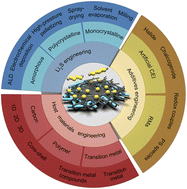Advanced engineering strategies for Li2S cathodes in lithium–sulfur batteries
Abstract
In the rapidly advancing landscape of portable electronic devices, lithium–sulfur batteries (LSBs) have risen to prominence as a viable successor to traditional lithium-ion batteries. This review delves into the potential of Li2S, showcasing it as an exemplary cathode with high energy density, safety, and efficiency for LSBs. However, these promising facets are shadowed by notable impediments to its practical deployment, including constraints like inadequate electronic and ionic conductivity, an elevated initial activation overpotential, and the vexing challenge posed by the shuttle effect. The review systematically explores various strategies for overcoming these hindrances, with a concentrated focus on the engineering of Li2S, host materials and additives. While existing literature has addressed Li2S cathode technology to some extent, this review goes a step further by meticulously examining neglected aspects like polycrystalline Li2S and artificial cathode electrolyte interfaces. Through a deep analysis of the redox process of the Li2S cathode and by integrating diverse engineering strategies into three coherent areas, the review serves as a comprehensive guide that illuminates new insights and charts future pathways in the pursuit of high-performance LSBs utilizing Li2S cathode materials.

- This article is part of the themed collection: Journal of Materials Chemistry A Recent Review Articles


 Please wait while we load your content...
Please wait while we load your content...